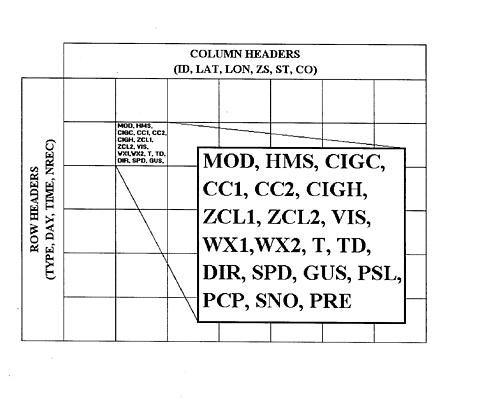
McIDAS Learning Guide
Version 2015
[Search Manual] [Table of Contents] [Go to Previous] [Go to Next]
MD files normally contain observational data for a specific time period, for example, a day or an entire year. MD files store the data in individual records for a specific location at a specific time. Each MD file contains individual records. A record contains observational data for a latitude and longitude at a specific time. For example, one record may include measurements of temperature, dew point, wind speed, wind direction, and sea level pressure at 15 UTC for Houston, TX. A single MD file may contain thousands of records.
MD files use the naming convention MDXXnnnn where nnnn is a four-digit number. For example, MDXX0013 is the file name for MD file 13. Most McIDAS commands use only the MD file number. However, you must use the MDXX prefix with the DMAP command or when using Unix commands to copy, move, or delete MD files.
MD files in the ISFC, IRAB, SYN, and GFSMOS schemas are arranged in a table of rows and columns as shown in the ISFC example below. Time and day information common to all records in the row appears in the row header. Similarly, a column header designates common information according to location. Therefore, all the records along a particular row represent the same time and all the records down a particular column are reports from the same location.
MD files in the IRSG, ISHP, and PIRP schemas have row headers, but not column headers because the reporting location changes.
**Note: On 25 January 2005 the North American Mesoscale forecast model (NAM) replaced the ETA model, creating a new schema, NAMMOS. In addition, NGMMOS, which is the same as DCFO14, was created at the same time to follow the more logical naming convention of the other MOS schemas (GFSMOS and NAMMOS). References to older models (like NGM and ETA) are still found in the Learning Guide because it has many examples from the 1993 "Storm of the Century" and those models were operational at that time.
| Schema | ADDE Dataset | |
| PIRP | RTPTSRC/AIRCRAFT | |
| GFSMOS | RTPTSRC/GFSMOS | |
| NAMMOS | RTPTSRC/NAMMOS | |
| NGMMOS | RTPTSRC/NGMMOS | |
| ISFC | RTPTSRC/SFCHOURLY | |
| ISHP | RTPTSRC/SHIPBUOY | |
| SYN | RTPTSRC/SYNOPTIC | |
| IRAB | RTPTSRC/UPPERMAND | |
| IRSG | RTPTSRC/UPPERSIG | |
| Schema | Years | |
| ISFC | 1976 to present | |
| IRAB/IRSG | 1977 to present | |
| ISHP | 1985 to present | |
| SYN | 1991 to present | |
[Search Manual] [Table of Contents] [Go to Previous] [Go to Next]